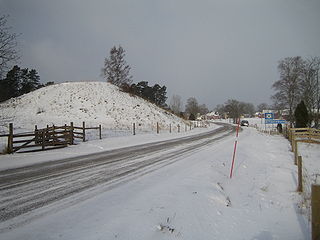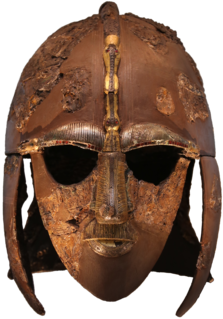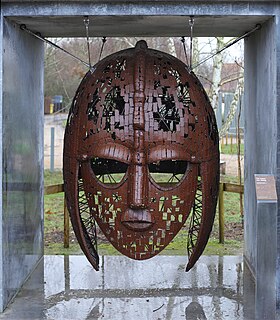
Rædwald, also written as Raedwald or Redwald, was a king of East Anglia, an Anglo-Saxon kingdom which included the present-day English counties of Norfolk and Suffolk. He was the son of Tytila of East Anglia and a member of the Wuffingas dynasty, who were the first kings of the East Angles. Details about Rædwald's reign are scarce, primarily because the Viking invasions of the 9th century destroyed the monasteries in East Anglia where many documents would have been kept. Rædwald reigned from about 599 until his death around 624, initially under the overlordship of Æthelberht of Kent. In 616, as a result of fighting the Battle of the River Idle and defeating Æthelfrith of Northumbria, he was able to install Edwin, who was acquiescent to his authority, as the new king of Northumbria. During the battle, both Æthelfrith and Rædwald's son, Rægenhere, were killed.

Sutton Hoo is the site of two early medieval cemeteries dating from the 6th to 7th centuries near the English town of Woodbridge. Archaeologists have been excavating the area since 1938, when a previously undisturbed ship burial containing a wealth of Anglo-Saxon artefacts was discovered. The site is important in establishing the history of the Anglo-Saxon kingdom of East Anglia as well as illuminating the Anglo-Saxons during a period which lacks historical documentation.

Barrington is a suburban, residential town in Bristol County, Rhode Island located approximately 7 miles (11 km) southeast of Providence. It was founded by Congregationalist separatists from Swansea, Massachusetts and incorporated in 1717.

Vendel is a village at Tierp Municipality in Uppland, Sweden. The village overlooks Vendelsjön, a long inland stretch of water near the Vendel river which has its confluence with the river Fyris. Vendel was the site of an ancient royal estate, part of Uppsala öd, a network of royal estates meant to provide income for the medieval Swedish kings. A large number of archaeological finds have been found here, which have given their name to the Vendel Period.

Rendlesham is a village and civil parish near Woodbridge, Suffolk, United Kingdom. It was a royal centre of authority for the king of the East Angles, of the Wuffinga line; the proximity of the Sutton Hoo ship burial may indicate a connection between Sutton Hoo and the East Anglian royal house. Swithhelm, son of Seaxbald, who reigned from 660 to around 664, was baptised at Rendlesham by Saint Cedd with King Æthelwold of East Anglia acting as his godfather. He died around the time of the great plague of 664 and may have been buried at the palace of Rendlesham.
Wehha is listed by Anglo-Saxon records as a king of the East Angles. If he existed, Wehha ruled the East Angles as a pagan king during the 6th century, at the time the region was being established as a kingdom by migrants arriving from what is now Frisia and the southern Jutland peninsula. Early sources identify him as a member of the Wuffingas dynasty, which was established around the east coast of Suffolk. Nothing of his reign is known.
Martin Oswald Hugh Carver, FSA, Hon FSA Scot, is Emeritus Professor of Archaeology at the University of York, England, director of the Sutton Hoo Research Project and a leading exponent of new methods in excavation and survey. He specialises in the archaeology of early Medieval Europe. He has an international reputation for his excavations at Sutton Hoo, on behalf of the British Museum and the Society of Antiquaries and at the Pictish monastery at Portmahomack Tarbat, Easter Ross, Scotland. He has undertaken archaeological research in England, Scotland, France, Italy and Algeria.
Basil John Wait Brown was an English archaeologist and astronomer. Self-taught, he discovered and excavated a 7th-century Anglo-Saxon ship burial at Sutton Hoo in 1939, which has come to be called "one of the most important archaeological discoveries of all time". Although Brown was described as an amateur archaeologist, his career as a paid excavation employee for a provincial museum spanned more than thirty years.

The Dig is a historical novel by John Preston, published in May 2007, set in the context of the 1939 Anglo-Saxon ship burial excavation at Sutton Hoo, Suffolk, England. The dust jacket describes it as "a brilliantly realized account of the most famous archaeological dig in Britain in modern times".

Rupert Leo Scott Bruce-Mitford, FBA, FSA was a British archaeologist and scholar, best known for his multi-volume publication on the Sutton Hoo ship burial. He was a noted academic as the Slade Professor of Fine Art at Cambridge University from 1978 to 1979, in addition to appointments at All Souls College, Oxford, and Emmanuel College, Cambridge.
Edith May Pretty was an English landowner on whose land the Sutton Hoo ship burial was discovered after she hired Basil Brown, a local excavator and amateur archeologist, to find out if anything lay beneath the mounds on her property.

The Sutton Hoo helmet is an ornately decorated Anglo-Saxon helmet found during a 1939 excavation of the Sutton Hoo ship-burial. It was buried around 625 and is widely associated with King Rædwald of East Anglia; its elaborate decoration may have given it a secondary function akin to a crown. The helmet was both a functional piece of armour that would have offered considerable protection if ever used in warfare, and a decorative, prestigious piece of extravagant metalwork. It is described as "the most iconic object" from "one of the most spectacular archaeological discoveries ever made", and perhaps the most important known Anglo-Saxon artefact.

The Sutton Hoo purse-lid is one of the major objects excavated from the Anglo-Saxon royal burial-ground at Sutton Hoo in Suffolk, England. The site contains a collection of burial mounds, of which much the most significant is the undisturbed ship burial in Mound 1 containing very rich grave goods including the purse-lid. The person buried in Mound 1 is usually thought to have been Rædwald, King of East Anglia, who died around 624. The purse-lid is considered to be "one of the most remarkable creations of the early medieval period." About seven and a half inches long, it is decorated with beautiful ornament in gold and garnet cloisonné enamel, and was undoubtedly a symbol of great wealth and status. In 2017 the purse-lid was on display at the British Museum.
Sutton is a village and a civil parish on the B1083 road, in the East Suffolk district, in the county of Suffolk, England. Sutton has a pub, a mobile post office and a place of worship. There is also the hamlet of Sutton Street and the Sutton Common estate nearby.

Herbert James Maryon, OBE, FSA, FIIC was an English sculptor, conservator, goldsmith, archaeologist and authority on ancient metalwork. Maryon practiced and taught sculpture until retiring in 1939, then worked as a conservator with the British Museum from 1944 to 1961. He is best known for his work on the Sutton Hoo ship-burial, which led to his appointment as an Officer of the Order of the British Empire.

Nigel Reuben Rook Williams was an English conservator and expert on the restoration of ceramics and glass. From 1961 until his death he worked at the British Museum, where he became the Chief Conservator of Ceramics and Glass in 1983. There his work included the successful restorations of the Sutton Hoo helmet and the Portland Vase.

Sutton Hoo Helmet is a 2002 sculpture by the English artist Rick Kirby. A representation of the Anglo-Saxon helmet by the same name found in the Sutton Hoo ship-burial, it was commissioned by the National Trust to suspend outside an exhibition hall at the Sutton Hoo visitor centre. At the opening of the centre, the sculpture was unveiled by the Literature Nobel laureate Seamus Heaney on 13 March 2002. It remained in place, dominating the entrance of the exhibition hall, until 2019, when it was moved to the entrance to the Sutton Hoo site.

Oulton is a civil parish on the western edge of the town of Lowestoft in the north of the English county of Suffolk. It is in the East Suffolk district. The eastern part of the parish forms part of the suburbs of Lowestoft, whilst the western section extends into The Broads national park, reaching the River Waveney and Oulton Dyke.















